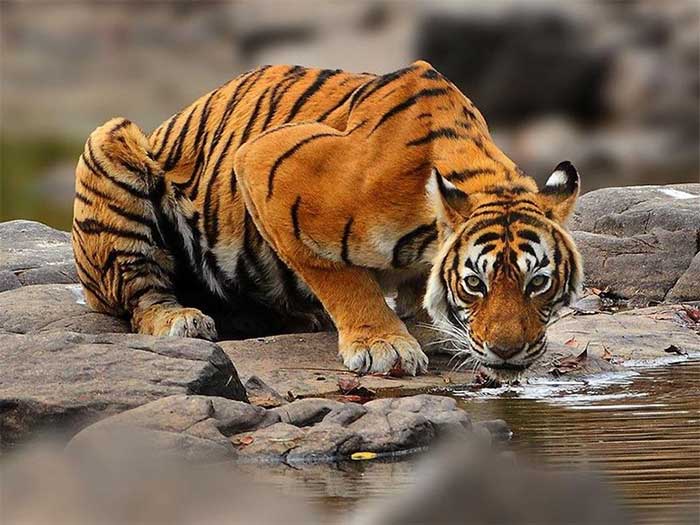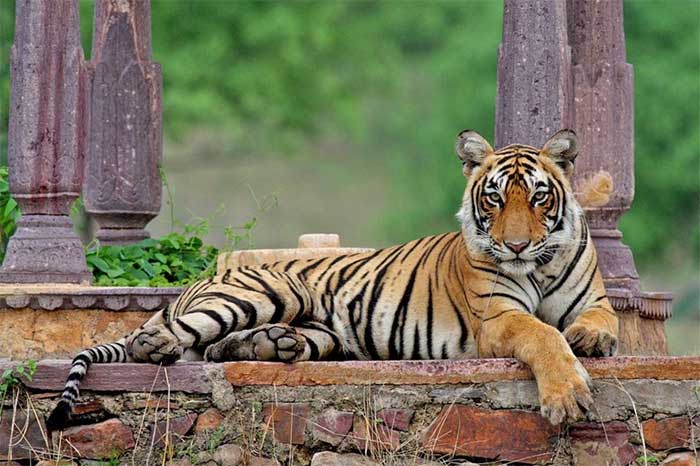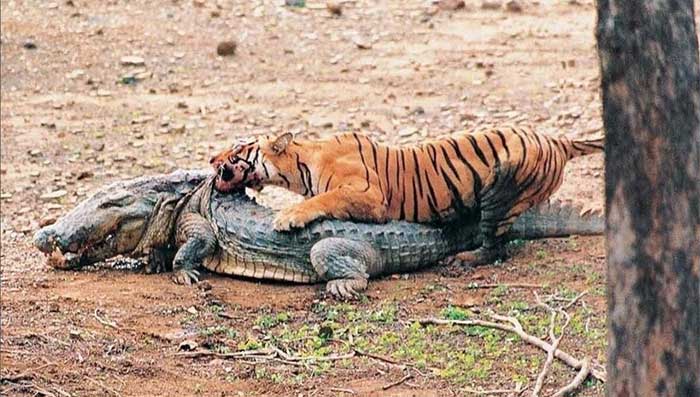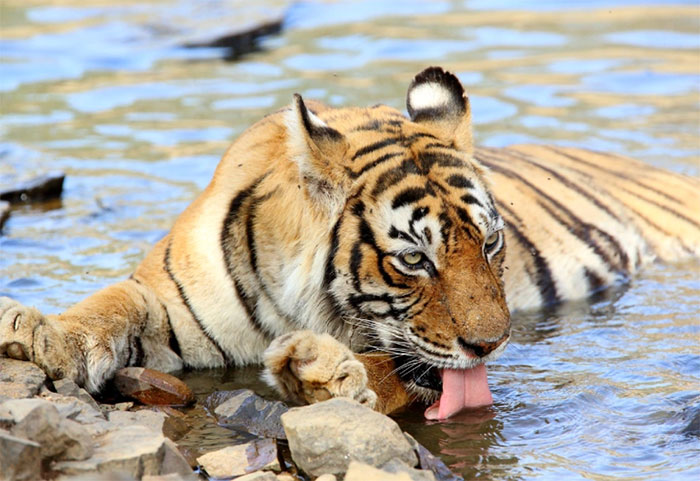With “Queen” Machali, taking down formidable crocodiles seems to be just part of its daily routine.
Once dominating the Ranthambore National Park in India, covering over 900 km2, and becoming an icon with its incredible achievements, “Tiger Queen” Machali is perhaps the most famous tiger in the world to date.

Machali is considered the most famous tiger in the world. (Photo: AP).
It has also provided wildlife enthusiasts with many memorable stories and inspired a series of documentaries, with “Tiger Queen” being the most notable, winning a National Award at the 66th National Film Awards.
The Legend of Machali T-16
Machali (meaning “fish” in Hindi) is a Bengal tiger (Panthera tigris tigris), born in 1997, and is the “big sister” dominating a litter of just three females. It was named Machali because it has fish-shaped markings on the left side of its face. It is also known by the code name T-16, given by the staff at Ranthambore National Park, or by the nickname “Lady of the Lake.”
Machali’s prowess as a dominant figure was evident early on when, within its first two years, it began hunting on its own. It also displayed unusual boldness by challenging its mother at a very young age. Upon victory, Machali became the queen of the Ranthambore lake area, a key territory for tigers in the Indian national park, which is also the largest and most beautiful region, covering 906 km2.

The majestic beauty of Machali the tiger. (Photo: AP).
Kalli Doubleday, a carnivore researcher at the University of Texas, Austin, has had a lifelong passion for big cats. Growing up, she learned about Machali and began researching it. Doubleday’s study published in Geoforum in February 2017 revealed special traits that set Machali apart from its peers.
According to the research, among the 62 tigers living in Ranthambore at that time, none were as arrogant and proud as Machali. The nickname “Lady of the Lake” was not given to Machali by chance, as it was an expert at dealing with “huge” crocodiles. Its usual victims were the famous Mugger crocodiles, measuring up to 4-5 meters long and weighing up to 200 kg.
Despite one being a land creature and the other aquatic, Bengal tigers and Mugger crocodiles frequently “cross paths” due to their overlapping territories. While Bengal tigers are large and powerful, they are also extremely cautious when facing Mugger crocodiles, as these reptiles are natural-born killers equipped with strong jaws capable of capturing and holding prey as large as deer and antelopes.
However, for Machali, taking down formidable crocodiles seems to be just part of its daily routine. Yet, there is one battle that forever etched Machali’s name in history, truly making it the “Queen” of the vast land.
In June 2003, when Ranthambore was hit by a severe drought, a massive crocodile, measuring 4.8 meters long, left its hiding place and entered the waterhole within Machali’s territory. After escorting her cubs to safety, Machali returned and left visitors “wide-eyed” as she took down the adversary in a fierce confrontation.

Machali always had a dominant nature and a strong personality in the pride.
The battle brought fame to Machali but also cost the “Queen” her sharp fangs – the weapons that instilled fear in many predators and wildlife. However, this did not diminish Machali’s ferocity. Despite being a female tiger, Machali always exhibited a dominant nature and a strong personality within the pride, at times even subduing male tigers.
Later in life, Machali had to raise her cubs while suffering from tooth loss and complete blindness in one eye. Yet, the “Tiger Queen” never failed to protect her young from large male tigers. In the tiger world, male tigers often kill cubs to persuade females to mate. Despite her disadvantages, Machali still stood her ground against these opportunistic threats.
Strong as she was, Machali showed an exceptional friendliness towards the camera, often lounging on her favorite rock, posing like a true queen for visitors to photograph.
Perhaps that is why Machali’s image has been featured everywhere, in countless magazines, newspapers, travel blogs, and she has become the most valuable “tiger model” on the planet.
Legacy and Achievements of the “Queen”

Machali gave birth to four litters, including 11 cubs – 7 females and 4 males.
“Queen” Machali played a crucial role in the conservation of the tiger species, particularly in the face of ongoing threats from poachers. Throughout her nearly 20-year life, she gave birth to four litters, producing 11 cubs – 7 females and 4 males.
Machali’s offspring significantly increased the tiger population in the park – from 15 tigers in 2004 to 50 tigers in 2014. Ultimately, more than half of the tigers in the park are descendants of Machali. In 2008, two of Machali’s female cubs were transferred to the Sariska Tiger Reserve, further boosting the tiger population in that area. At that time, the number of tigers sighted in Ranthambore had quadrupled within a decade.
Not only did she bring fame to her pride, but also to the vast Ranthambore National Park, attracting thousands of visitors to the area each year. At one point, it was estimated that Ranthambore National Park generated 220 billion VND (converted) in revenue annually just from ticket sales, with most visitors coming to catch a glimpse of the legendary “Tiger Queen.”
Machali’s influence was so significant that the Tiger Tourism Organization (TOFT) awarded the “Queen” a lifetime achievement award in 2009 for her contributions to conservation and tourism.
The Indian government also issued commemorative covers and postage stamps to honor Machali for her economic and ecological contributions as the “Queen.”
Even as Machali aged, authorities kept her in the Rajasthan park and provided food for her. Each day, they would bring an animal, such as a goat, and tie it to a tree for Machali. Despite having lost most of her teeth, the “Queen” still had the strength to kill her prey due to her powerful bite.

Machali was buried according to Hindu tradition. (Photo: AP).
In August 2016, on a beautiful sunny day, Machali sought a quiet place, lay down, and never woke up again. Such a scene deeply moved the staff working at the national park.
Typically, Bengal tigers live for only 12 to 14 years. However, at the time of Machali’s death, she was over 19 years old. After her passing, she was buried according to Hindu tradition, her body wrapped in white cloth and covered with flowers. All park staff attended Machali’s cremation ceremony, which is regarded as one of the most special moments in the history of wildlife conservation worldwide.


















































